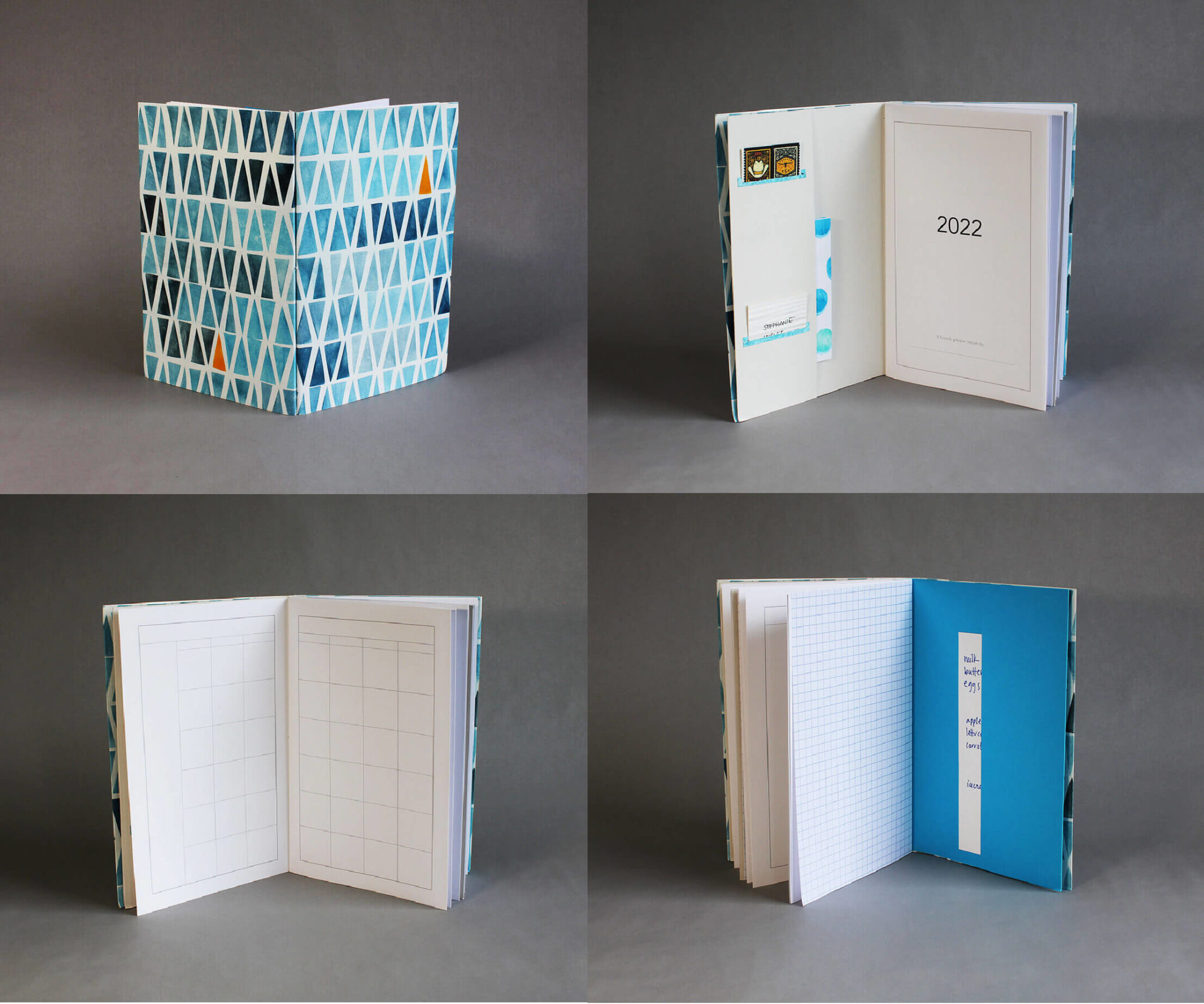Workshops
Learn how to create a simple two-signature softcover journal for your new year (or anytime) thoughts, sketches, contacts notes, or calendar.
There are no available registration dates at this time.
NOTE: This Class will meet in a live, online format using the Zoom Platform.
Class meets on Oct 23, 2022, Sunday 1-4:30pm EST.

We will create a simple two-signature softcover journal to be used for notes and thoughts during a new year, a new month, or a new season. Each participant will choose what to add to their book: calendar pages, plain or gridded paper for notes or sketches, a place for contacts. The journal will be bound with two sections and will have some pockets, both side and top-loading. Along with making our journals, we will cover ideas and resources for keeping one. Access to a printer or copy shop is needed to print out some of the materials provided, such as calendar and contact pages, should you wish to add them. PDF files and instructions will be sent prior to the workshop. Please note that the structure of this journal has some thickness limitations, so this journal wouldn’t be large enough for daily calendar pages. It can also be made without a calendar. If you run out of space, you can make more, as the calendar’s days are numbered by hand. The binding is adaptable to other kinds of content and uses. Basic bookbinding skills will be useful for this workshop.
Tools needed:
- Bone folder
- Scissors
- 2 binders clips, small or other clips (bulldog clips, paper clips)
- Awl or piercing tool
- Ruler, 12” metal
- Pencil
- Glue stick
- Cutting mat
- X-acto knife
- Right triangle
- Sewing needle
- Japanese hole punch (optional)
- Beeswax or paraffin (optional)
- Access to printer or copy shop prior to workshop (to print optional calendar pages that will be sent)
Material needed:
- Double-sided tape, ¼” – ½” wide. About 4 feet. 3M #415 is the kind I use, as it has a paper backing which is helpful.
- Thread, about 36 inches. Linen bookbinding thread (#18/3 or other), button and carpet thread, or other craft thread.
All paper grain should be parallel to the height measurement, so for these papers, parallel to the 8.5”
- A handmade paper suitable for a paper case binding, such as Cave Paper or St. Armand
- Fabriano Tiziano (160 gsm) or Canson Mi Tientes (98 lb/160 gsm)
Text block paper:
- 8-15 sheets of 8.5” high x 11” wide paper.
Various kinds: plain, graph, or any other that you like to use. Text-weight, 70-80 lb. text weight best. Copy paper can be used and some copy shops have nice choices. This paper can be printed with any of the PDFs provided: calendar, notes, contacts, or title pages, which will be sent prior to the workshop. 10 is probably about the right number of sheets of paper for the book.
For small and side pockets in the front:
- 1 sheet of 8.5” high x 17” wide paper
Cover weight or card stock, 65-80 lb. best.
Other possible options: 90 lb. watercolor paper, Fabriano Tiziano (160 gsm), or
Canson Mi Tientes (98 lb./160 gsm)
If you can’t find paper 17” wide, you will need at least 12” wide paper.
(If you want a full-page fold-out, cut the paper wider, to 22.25”.) - Tyvek: A few small pieces, about 3” x 3” A piece of a Tyvek mailing envelope will work fine.
You can color the Tyvek prior to the workshop if you wish, by rubbing acrylic ink over it.
Then buff with a paper towel.
For a side pocket in the back:
- 1 sheet of 8.5” high x 11” wide paper
Cover weight or card stock, 65-80 lb.
Or a substitution of papers, as for the front pockets (see above).
Share This

Instructor: Stephanie Wolff
Stephanie Wolff works with paper, text, textile, and the book form, with projects that explore themes of weather, history, and rural life, among other topics. Her artist books are held in many public and private collections, and have been exhibited in the United States and Germany. Her works are included in 500 Handmade Books, Volumes 1 & 2 (Lark Books). She has been awarded fellowship/residencies, including from the American Antiquarian Society and the Jaffe Center for Book Arts. Stephanie’s years as a book conservator at the Dartmouth College Library provided her with experience in the care and repair of a wide range of library materials, from books and manuscripts to maps, scrapbooks, and other objects. This conservation work included the creation of housing for display and storage of rare and fragile items. Her early experience in pre-digital photography—combined with a background in book arts, binding, and conservation—gives her a rich knowledge base with a range of possibilities for designs, including those that combine book forms with photographic or printed images. As a longtime teacher of book arts to college students and others, she enjoys sharing her knowledge from bookbinding, book conservation, and fine arts to help people transform their ideas into tangible creations.



